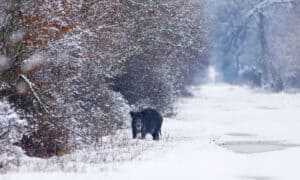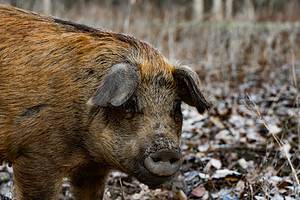There are many cool animals in Wisconsin, including feral hogs. Do you have to worry about them if you visit? This article will investigate these wild pigs, where they live, and if they’re dangerous.
What Are Feral Hogs?
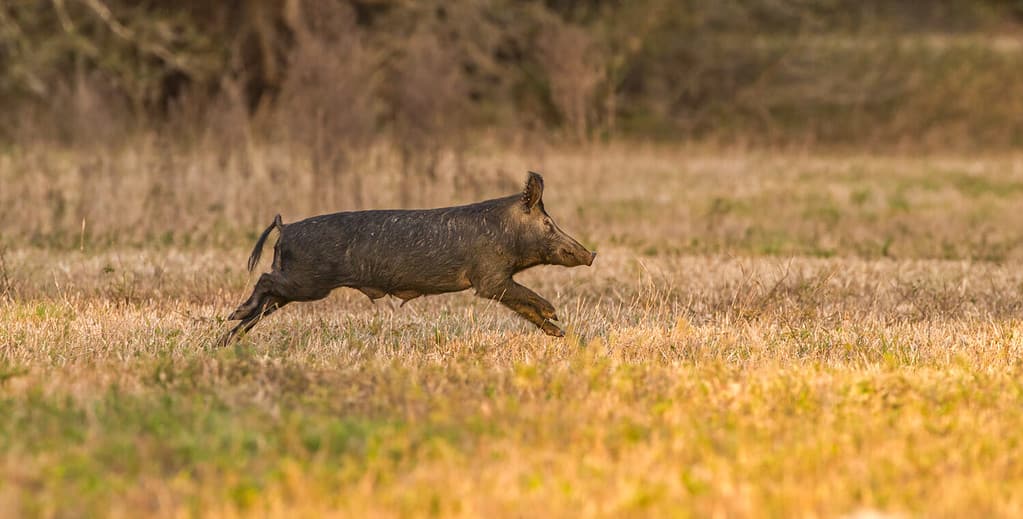
Feral hogs are descendants of domestic pigs.
©Chase D’animulls/Shutterstock.com
Feral hogs, also known as wild boars or wild pigs, are non-native, domesticated pigs that have returned to a wild state in North America. Descendants of domestic pigs came with European settlers to North America and established populations across the continent. Feral hogs have a compact, sturdy build with a prominent head, elongated snout, and sharp tusks. Their bristly hair can vary in color from dark brown to black. Adults weigh between 100 and over 400 pounds and stand around 3 to 4 feet tall at the shoulder. They are prolific breeders. Sows reach sexual maturity at 6 to 8 months old and have litters of 4 to 6 piglets.
In North America, feral hogs are most prevalent in the southern United States, including Texas, Florida, Louisiana, and parts of the Southeast. They cause significant ecological and agricultural damage in these regions. While smaller and more localized populations exist in some western states like California, Oregon, and Washington, their presence is not as widespread as in the South. Feral hogs also inhabit parts of the eastern United States, such as Arkansas, Tennessee, and the Carolinas, although their distribution there is patchy. In Canada, feral hogs exist in Saskatchewan and Manitoba, but their presence is limited and localized. Generally, feral hogs classify as an invasive species and pose significant challenges to ecosystems, agriculture, and native wildlife. Efforts to control and manage their populations are ongoing to mitigate their detrimental impacts.
What Types of Habitats Do They Live In?
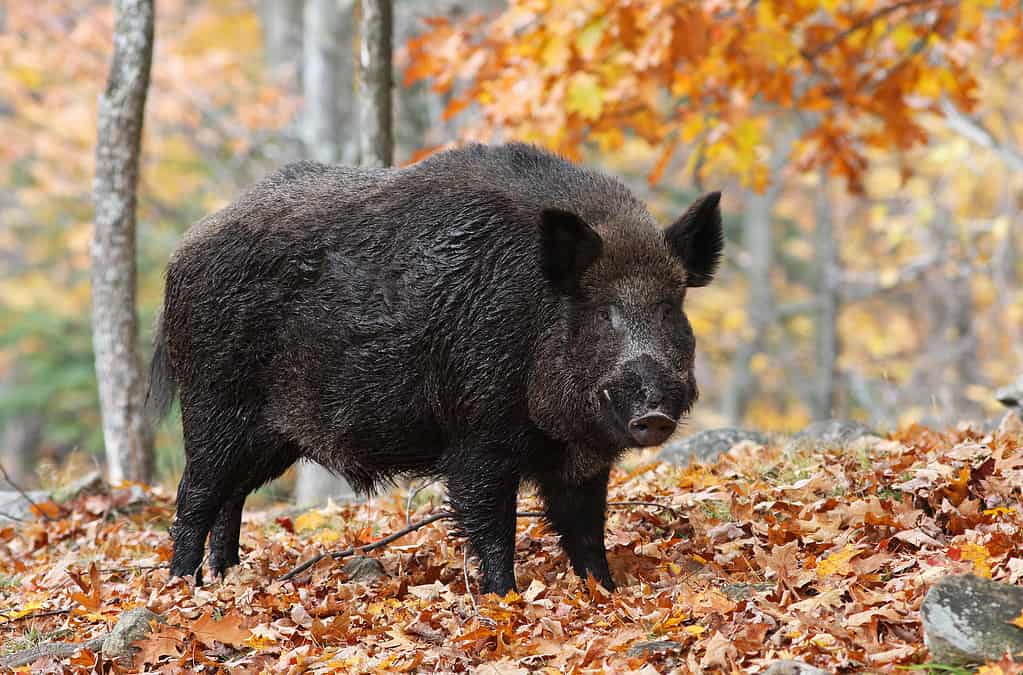
This male feral swine is in a deciduous forest environment.
©Mircea Costina/Shutterstock.com
Feral hogs are highly adaptable and inhabit various habitat types in North America. They commonly live in forests, swamps, grasslands, and agricultural areas. They thrive in both deciduous and coniferous forests and utilize the understory for cover and foraging on vegetation and roots. In swamps, they navigate through wetland environments, feeding on aquatic plants, tubers, and invertebrates. Feral hogs can also adapt to open grasslands, where they graze on grasses and forbs. Additionally, they tend to venture into agricultural fields, damaging crops and causing economic losses. The ability of feral hogs to exploit a wide range of habitats contributes to their successful establishment and proliferation across different regions of North America.
Where Do Feral Hogs Live in Wisconsin?
There are reports of feral hogs in certain parts of Wisconsin, but their presence and distribution in the state are relatively small. The Wisconsin Department of Natural Resources (WDNR) has classified feral hogs as an invasive species and has been actively working to prevent their establishment and manage any populations that may arise.
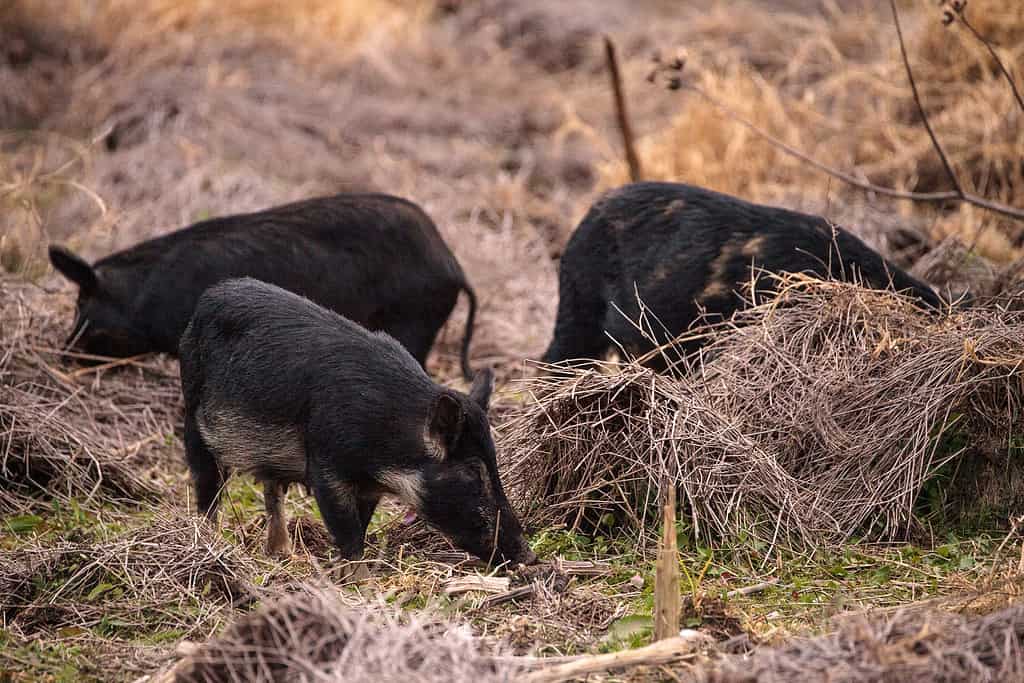
Feral pigs can damage landscaping and agriculture and are an invasive species.
©SunflowerMomma/Shutterstock.com
Feral hogs in Wisconsin are mainly in the southwestern part of the state, specifically in Crawford, Grant, and Iowa counties. These areas have sporadic sightings of feral hogs. The WDNR, in collaboration with landowners, hunters, and other stakeholders, enforces measures to prevent the expansion of feral hogs and attempts to promptly respond to any reports. These efforts aim to protect Wisconsin’s ecosystems, agricultural lands, and native wildlife from the negative impacts associated with feral hog populations.
Are Feral Hogs Dangerous?

Feral hogs can become defensive if they are protecting their offspring.
©Slatan/Shutterstock.com
Feral hogs can be potentially dangerous, especially when they feel threatened or cornered. They have a strong, muscular build, sharp tusks, and can exhibit aggressive behavior if provoked. Incidents involving feral hog attacks on humans in Wisconsin are relatively rare. While feral hogs can be unpredictable and defensive, they generally avoid human interaction and prefer to flee when encountered. Exercise caution around feral hogs as they can be powerful and potentially dangerous animals.
It’s worth emphasizing that interactions between humans and feral hogs should be minimized, and it is advisable to maintain a safe distance and not attempt to approach or provoke them. If anyone encounters a feral hog or observes their presence, contact the Wisconsin Department of Natural Resources or local wildlife authorities for guidance on appropriate actions and reporting procedures.
What Dangerous Animals Live in Wisconsin?
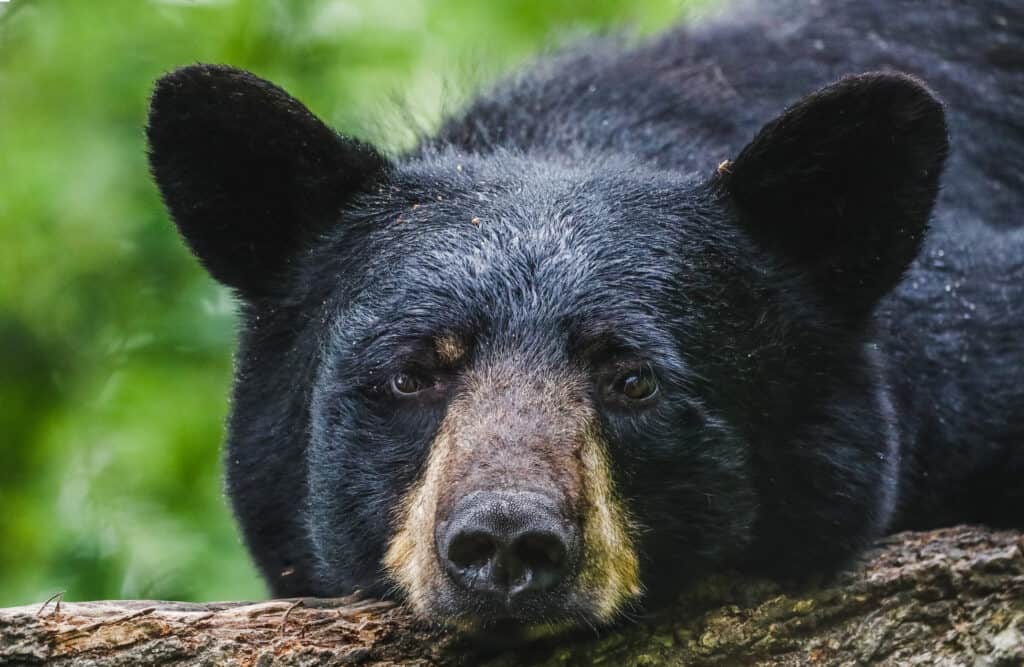
There are black bears in Minnesota, which pose a more significant threat than wild hogs.
©iStock.com/Mandy Fuller Photography
Wisconsin is home to a variety of wildlife, and while most animals pose no threat to humans and typically avoid interactions, there are a few species that can potentially be dangerous. One such animal is the black bear (Ursus americanus), which lives in certain parts of the state. While black bears are generally shy and tend to avoid humans, they can become aggressive if they sense a threat or if their cubs are in danger. It is important to follow guidelines for bear encounters and properly secure food and garbage to minimize potential conflicts.
Another potentially dangerous species is the timber rattlesnake (Crotalus horridus), which inhabits a small range in the southwestern part of Wisconsin. Timber rattlesnakes are venomous and should be approached with caution. They are generally reclusive and will only bite if cornered or provoked. Other potentially dangerous animals in Wisconsin include the gray wolf (Canis lupus) and the cougar (Puma concolor), although encounters with these large predators are rare. It is crucial to remember that respecting wildlife, maintaining a safe distance, and understanding their behavior is key to minimizing any potential risks.
The photo featured at the top of this post is © Slatan/Shutterstock.com
Thank you for reading! Have some feedback for us? Contact the AZ Animals editorial team.




